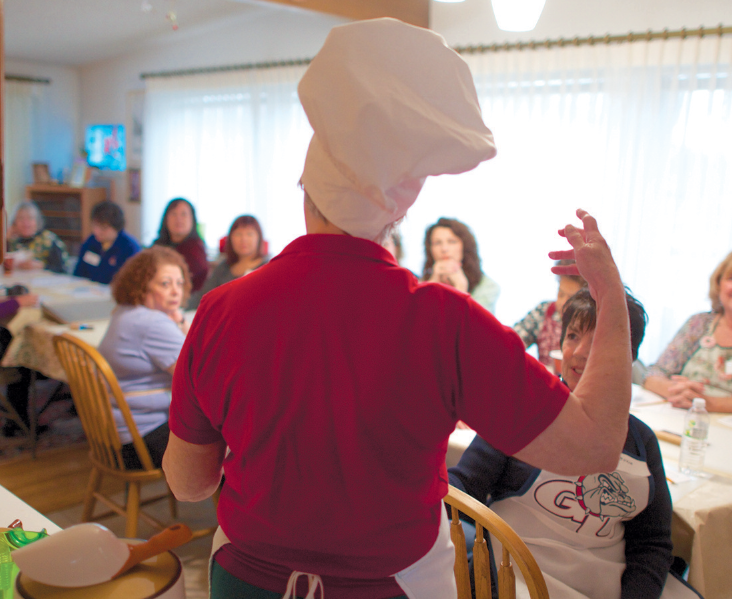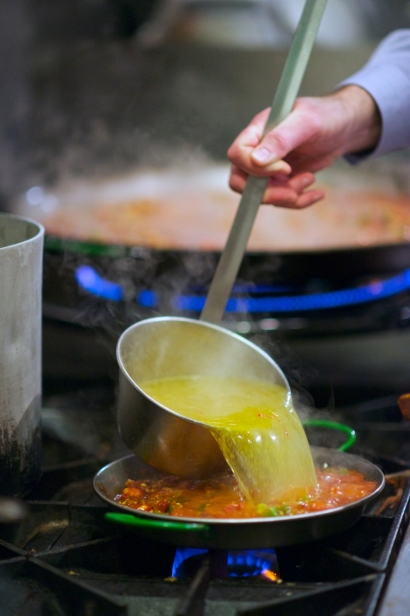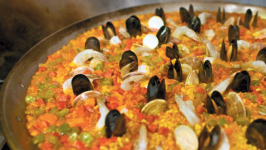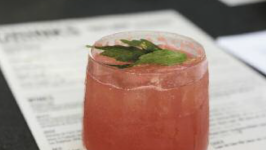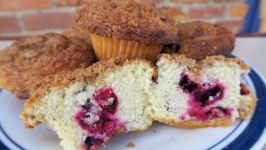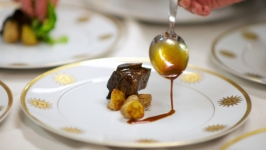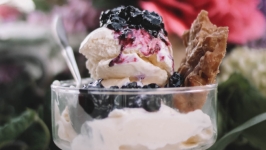What’s Cooking?
When the overlords at Edible Idaho South called asking if I’d be willing to sample several of southern Idaho’s growing array of cooking classes and write about it, I thought, “No shopping for ingredients, prepping or cleaning up, while getting a delicious meal and acquiring mad cooking skills? Why not?”
First on the list, The Basque Market offers Paella Wednesdays. This popular dish of rice, chicken, beef or fish was something I had never tried. Under glowing lights, the market had a party vibe— and no wonder paella-making is an event.
“What does it take to be paella?” asked co-owner Tony Eiguren, teaching with his wife, Tara.
We heard the qualifications: The national dish of Spain can contain rice, saffron, chicken stock, seafood, but the real answer, Tony said, is “anything that’s cooked over a fire or oversized grill in a wide, flat, green-handled paella pan.” Another Old World caveat: it has to be made by a man.
“So I make it,” a grinning Tara Eiguren says, “then hand him the spatula.”
The evening’s paellera hosted shrimp, mussels, chorizo, chicken, onion, green pepper, minced garlic, smoked paprika, olive oil, white wine, pimentos, chicken broth, saffron, salt and special occasion Valenciana rice, grown specifically for paella.
Never stirring is key. Each piece of meat and seafood is placed individually and thoughtfully, then evenly cooked by rotating the pan over low heat, encouraging flavor blending and a crust called socarrat to form at the bottom. Those obtaining socarrat portions hold bragging rights.
Garlic is added toward the end, Tara Eiguren says, because someone (referring to Tony) “might have burnt it once.”
Hearing paella described as an “out of body” experience, I wondered how out of body a rice combination could really be. After tasting, my response was: “I knew.”
Rudy’s A Cook’s Paradise was next, touting Magic Valley Medical Center’s Chef Aaron Lewis’ authentic barbeque. As guests arrived, I overheard, “She doesn’t cook, and I love to eat.”
“Will you talk loud, Chef Aaron?” a student in the back requested.
“No,” said the chef, setting precedence as humor was sprinkled liberally throughout the evening.
“Barbecue’s beauty is in the way it’s seasoned, and in the brine. Salt water makes everything around it consistent. If brined for too long, you’re curing. It has something to do with magic,” he quipped, moving deftly around Rudy’s well-equipped demo kitchen.
Chef Aaron and staff created forty portions of beef brisket, sausage, baked beans with fennel, spare ribs, crispy potatoes, brined smoked chicken, homemade cabbage and apple coleslaw.
“Never barbecue over 225 degrees; otherwise, you’re grilling,” he advised, adding, “When you first start barbecuing, it’s trials and tribulations.”
We were told simmering sauces made essential oils “bloom,” that blackened “smoke rings” were beautiful, that adding celery leaves provided freshness, and that barbecue, Chef Aaron says, was invented by Southern slaves, making inferior meat cuts palatable. Above all, the motto was “slow and low.”
“How long should the beans cook?” someone asked.
“Till they’re done,” Chef Aaron deadpanned.
“It’s…delicious…with that….smoked flavor,” said someone between bites, amidst audible lip-smacking and finger-licking. The evening’s fare was divine.
Lastly, the Italian American Club of Boise, held at Guido and Angie Fabbi’s residence.
Angie instructed the breadstick making. When my perfectly formed breadsticks were approved, I rejoiced. They’d go well with Chicken Cacciatore, which, Guido shared, meant ‘hunter’ in Italian. He said upland game and rabbit worked well in Cacciatore, too.
Again, method mattered as chicken breasts were dipped first into flour, then egg with herbs, then dry parmesan cheese. As grilled parmesan aroma manifested, we inhaled hungrily.
“Keep olive oil from the chicken in your pan when cooking veggies. There’s flavor in that,” daughter Monica Fabbi admonished. “And make sure mushrooms touch the pan. You want to sauté, not steam.”
“The longer you cook onions, the more flavorful,” she said, “and garlic cooks really fast.”
Familiar words. Monica placed garlic on a ledge of mushrooms to avoid overcooking.
“I’m smarter than I look,” she laughed, and Angie nodded.
Cacciatore-laden plates were presented. One student, sopping up rich, flavorful sauce, asked Angie, “Are we allowed to do this?”
“Oh, yeah, I wish you would,” she replied cheerfully as someone called out, “This is like a big party, you know!”
All the more reason to sign up for one of southern Idaho’s next available local cooking classes.
The Basque Market | @thebasquemarket
Rudy’s A Cook’s Paradise | @cooksparadise
Magic Valley Medical Center
Italian American Club of Boise


